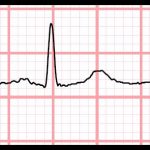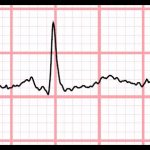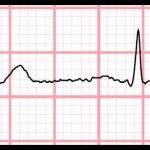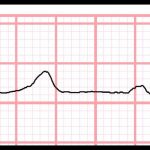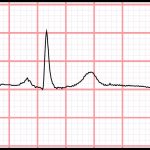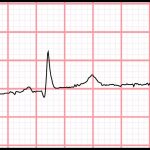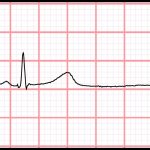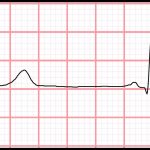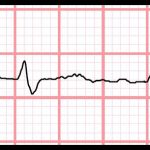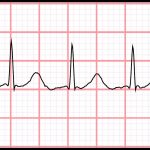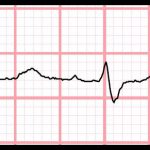Page Contents
OVERVIEW
This page covers one of the initial basic steps that must be taken when interpreting electrocardiograms (EKGs/ECGs) which is rate determination.

IMPORTANT BACKGROUND: SIZE/MEANING OF BOXES ON EKG PAPER
Given that calculating the heart rate is the topic of this page, it is now important to take a close look at the boxes that are printed on EKG paper and understand what they represent. There are large and small boxes typical seen on EKG tracing paper.

A few good numbers to keep in mind are the following:
- The speed of a typical EKG reading is 25 mm/sec.
- Each small box is 1 mm x 1 mm in size (width represents 0.04 s)
- Each large box (5 small boxes per large box) is 5 mm x 5 mm in size (width represents 0.20 s)
- There are 1500 little boxes in 1 min
- The heart rate (estimated from 2 points) will be: 1500/# of boxes between points
CALCULATING HEART RATE BY USING THE 10 SECOND STRIP: METHOD 1
There are multiple methods of doing this, however perhaps the most intuitive is to realize that 10 second strips are reported at the bottom of an EKG, and that multiplying the number of QRS complexes by 6 in this 10 second strip will give the number of heart beats in one minute. See the example below.

CALCULATING HEART RATE BY CALCULATING R-R DURATION: METHOD 2
Another way to calculate a heart rate is to calculate the distance between two R peaks on the tracing (R-R duration) and divide 60 by it (60/R-R duration = heart rate). See the example below.

CALCULATING HEART RATE BY APPROXIMATING R-R DURATION: METHOD 3
Calculating the heart rate by counting R peaks or small boxes between peaks sometimes can be too labor intensive. In that case often times the heart rate can be calculated by using large boxes to approximate the R-R duration. This method is generally used by most to quickly calculate the heart rate.

Here are some important values to try and remember in order to expedite your calculation of heart rate on an EKG by approximating the R-R duration. The distance of big boxes between peaks can estimate the heart rate as laid out below:
- 1 big box = 300 beats/min (duration = 0.2 sec)
- 2 big boxes = 150 beats/min (duration = 0.4 sec)
- 3 big boxes = 100 beats/min (duration = 0.6 sec)
- 4 big boxes = 75 beats/min (duration = 0.8 sec)
- 5 big boxes = 60 beats/min (duration = 1.0 sec)
- 6 big boxes = 50 beats/min (duration = 1.2 sec)
*A R-R duration between 3-5 boxes will give you a heart rate that is normal (between 60-100 bpm)
EXAMPLES OF A NORMAL HEART RATE ON EKGS
Bellow is a gallery of examples that show lead I from EKGS conducted in patients who have normal heart rates (between 60-100 bpm). This is an opportunity to practice method 3 (from above) to quickly calculate the heart rate in these patients. The actual heart rate of the patient is listed in the caption. CLICK ON THE THUMBNAILS BELOW TO OPEN UP THIS IMAGE GALLERY.
EXAMPLES OF A BRADYCARDIA ON EKGS
Bellow is a gallery of examples that show lead I from EKGS conducted in patients who have slower than normal heart rates/bradycardia (below 60 bpm). This is an opportunity to practice method 3 (from above) to quickly calculate the heart rate in these patients. The actual heart rate of the patient is listed in the caption. CLICK ON THE THUMBNAILS BELOW TO OPEN UP THIS IMAGE GALLERY.
EXAMPLES OF A TACHYCARDIA ON EKGS
Bellow is a gallery of examples that show lead I from EKGS conducted in patients who have faster than normal heart rates/bradycardia (above 100 bpm). This is an opportunity to practice method 3 (from above) to quickly calculate the heart rate in these patients. The actual heart rate of the patient is listed in the caption. CLICK ON THE THUMBNAILS BELOW TO OPEN UP THIS IMAGE GALLERY.
Page Updated: 03.04.2018
